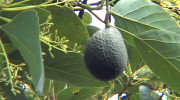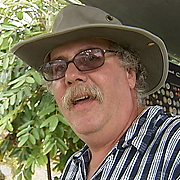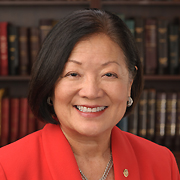Starting in October, growers of the green fruit will be able to send their harvest off to 32 states – mostly northern – without the required fumigation that is said to ruin the quality of the product.
The ban went into effect after the discovery of invasive oriental fruit fly larvae in an avocado packing house in Hawaii. The USDA decided to lift the ban after steady avocado advocacy from Hawaii’s Congressional delegation over many years. Scientists found the Sharwil to be a poor host for the fruit fly.
Sharwil avocados are grown on approximately 280 Hawaii farms, primarily on Hawaii Island.
This video was produced a few years ago and comes to us courtesy of Hawaii Tropical Fruit Growers. In it, Bruce Corker of Rancho Aloha in Holualoa explains the virtues of the Sharwil.
Avocados are a staple of Hawaii agriculture, even if they have had trouble finding a mainland market. Every year, the fruit is celebrated with a festival in Kona. That’s where we first met Tropical Fruit Grower Ken Love, who was outspoken on the shipping ban at the time (Feb. 2009).
The new shipping allowance comes with conditions. Places of production and packinghouses would have to be registered and monitored. There would also have to be an orchard trapping program, grove sanitation, limits on harvest periods and distribution areas, and harvesting and packing requirements to ensure that only intact fruit that have been protected against infestation are shipped.
Reaction
Adapted from the Federal Registrar
| Interstate Movement of Sharwil Avocados From Hawaii
ACTION: Final Rule. SUMMARY: We are amending the Hawaii quarantine regulations to allow the interstate movement of untreated Sharwil avocados from Hawaii into the continental United States. As a condition of movement, Sharwil avocados from Hawaii will have to be produced in accordance with a systems approach that includes requirements for registration and monitoring of places of production and packinghouses, an orchard trapping program, grove sanitation, limits on harvest periods and distribution areas, and harvesting and packing requirements to ensure that only intact fruit that have been protected against infestation are shipped. This action will allow for the interstate movement of Sharwil avocados from Hawaii into other States while continuing to provide protection against the introduction of quarantine pests. Effective Date: October 15, 2013. Background: Under the regulations in 7 CFR part 318, “State of Hawaii and Territories Quarantine Notices” (referred to below as the regulations), the Animal and Plant Health Inspection Service (APHIS) of the U.S. Department of Agriculture (USDA or the Department) prohibits or restricts the interstate movement of fruits, vegetables, and other products from Hawaii, Puerto Rico, the U.S. Virgin Islands, and Guam to the continental United States to prevent the spread of plant pests that occur in Hawaii and the territories. Among other things, the regulations allow interstate movement of Sharwil avocados from Hawaii to the continental United States only if the avocados undergo fumigation, or combined fumigation and cold treatment for fruit flies. The treatments currently required for the movement of Sharwil avocados can have unacceptable adverse effects on the quality of the fruit. On February 7, 2013, we published in the Federal Register (78 FR 8987-8992, Docket No. APHIS-2012-0008) a proposal [1] to amend the regulations to allow the interstate movement of untreated Sharwil avocados from Hawaii into the continental United States under a systems approach. The proposed conditions included that Sharwil avocados from Hawaii would have to be produced in accordance with a systems approach that includes requirements for registration and monitoring of places of production and packinghouses, an orchard trapping program, grove sanitation, limits on harvest periods and distribution areas, and harvesting and packing requirements to ensure that only intact fruit that have been protected against infestation are shipped. We solicited comments concerning the proposed rule for 60 days ending April 8, 2013, and received 30 comments by that date. They were from avocado growers and grower associations, researchers, members of Congress, a State plant regulatory agency, and an organization representing State plant regulatory agencies. These comments are discussed below by topic. Support for the Proposed Rule: Many commenters stated that they were confident that Sharwil avocados could safely move to the mainland in accordance with the requirements of the proposed rule and that the strengthened mitigation measures would prevent shipment of any fruit with viable fruit fly larvae. Many commenters also stated that the proposed rule would benefit Hawaii avocado growers, the economy of Hawaii, and consumers on the mainland. Trapping in Production Areas: Two commenters addressed actions to be taken if traps find Bactrocera dorsalis, the Oriental fruit fly, in the production area. The proposed rule states “Consistent with the recommendations of the RMD [risk management document], the compliance agreement would initially require bait sprays approved by APHIS to be used to control fruit flies in the orchard if B. dorsalis is detected by the trapping at a rate above 0.4 flies per trap per day.” One commenter stated that a detection rate of 0.1 flies/trap/day should be used as the trigger for bait spray in place of the proposed 0.4 flies/trap/day. We are not making any change in response to this comment. B. dorsalis is known to exist in Hawaii’s agricultural areas, and the purpose of the trapping requirement is only to demonstrate a low level of prevalence in the immediate vicinity of the Sharwil orchards. The suggested trapping rate of 0.1 flies/trap/day (based on the minimum of 2 traps we proposed to require for small orchards) would trigger action if 2 or more flies are caught in a week. This trigger level is more suitable to pest free areas than to low prevalence areas. We believe the proposed trigger of 0.4 flies/trap/day, which equates to 6 flies/week for small orchards, is a more realistic and practical trigger. The Sharwil avocado is considered an extremely poor host to B. dorsalis, and demonstrating that places of production have a low prevalence of B. dorsalis is an effective mitigation. This commenter also suggested that Mediterranean fruit fly (Medfly) population size should also be monitored through trapping, with the same bait spray triggers in place as for B. dorsalis. We are not making any change based on this comment. As noted in the proposed rule and the pest risk assessment, Sharwil avocado is not a host for Medfly and movement of Sharwil avocados is not a pathway for introduction of Medfly. Therefore, we have determined that restrictions associated with Medfly in this case are not necessary. Another commenter stated that, in addition to trapping and bait spray requirements for orchards, these requirements should also apply to surrounding buffer areas outside the orchard. The commenter also stated that, if trapping triggers a bait spray response, shipping from the orchard should be discontinued for 30 days and resume only after bait spray completion and subsequent negative trapping results. We are not making changes in response to these comments for the following reasons. Buffer zones are necessary in cases where articles are grown in a pest-free area, or whenarticles are a good host to a pest prevalent in the area (such as late-season citrus grown in areas infested with Caribbean fruit fly). Neither of these conditions applies in the case of Hawaii Sharwil avocados. Establishing buffer zones would also be impractical because many Sharwil orchards are small properties where the growers do not own the immediately surrounding land. With regard to actions to be taken when trapping results exceed the threshold, the proposal deliberately provided APHIS with discretion in this matter in § 318.13-20(c)(2), which states “If B. dorsalis is detected by the trapping at an actionable rate as specified in the compliance agreement, control actions required by the compliance agreement or ordered by an inspector must be taken.” This would allow for a variety of responses depending on the situation at the particular orchard, including such actions as increased trapping or increasing the size of the biometric sample of cut and inspected fruit. If infested fruit are ever found, shipping from that orchard would be suspended not just for 30 days, but until APHIS conducts an investigation and appropriate remedial actions have been implemented. Movement of Avocados From Place of Production to Packinghouse: One commenter expressed concern that the proposed requirement that avocados “must be safeguarded by an insect-proof screen or plastic tarpaulin while in transit to the packinghouse and while awaiting packing” would not prevent infestation during that movement. Another commenter stated that the proposed requirement that avocados must be moved to a packinghouse within 12 hours of harvest allowed the avocados to sit in the harvest area for too long. A search of relevant data and journal articles revealed no instance where fruit awaiting packing was attacked and infested by fruit flies; however, APHIS is aware that this is a remote possibility, as evidenced by the proposed requirements. In response to these comments, we reviewed the practices in other relevant programs and are changing the allowed postharvest time period to 3 hours to be consistent with them. We are not changing the proposed requirement that avocados “must be safeguarded by an insect-proof screen or plastic tarpaulin while in transit to the packinghouse and while awaiting packing,” which is also the standard in the other programs and appears to be a clear and effective standard. Fruit Box Labeling: One commenter addressed the proposed labeling requirement, that fruit boxes must be marked “Distribution limited to the following States: CO, CT, DE, DC, ID, IL, IN, IA, KS, KY, ME, MD, MA, MI, MN, MO, MT, NE, NH, NJ, NY, ND, OH, PA, RI, SD, UT, VT, VA, WA, WV, WI, and WY.” He suggested that the marking should also state “NOT FOR DISTRIBUTION TO [list of States that prohibit entry]” to insure that the product is not moved into fruit fly habitat States such as Florida. APHIS believes that it would be redundant and possibly confusing to mark every box with a list of States where distribution is allowed and another list consisting of all remaining States. However, we agree that further emphasizing the importance of limited distribution may help with program implementation. Therefore, we have amended the relevant requirement in § 318.13-20(e) to read: “Fruit boxes must be clearly marked `Distribution limited to the following States: CO, CT, DE, DC, ID, IL, IN, IA, KS, KY, ME, MD, MA, MI, MN, MO, MT, NE, NH, NJ, NY, ND, OH, PA, RI, SD, UT, VT, VA, WA, WV, WI, and WY; DISTRIBUTION TO OTHER STATES PROHIBITED’ and each consignment must be identified in accordance with the requirements of § 318.13-3(g).” Transit Shipments and Layovers: Two commenters asked what the proposed rule would allow in terms of transit movement or layovers for shipments of Sharwil avocado to the mainland. For example, a plane carrying Sharwil avocados could stop in California first before making its way to Connecticut. APHIS agrees that such situations are not clearly addressed in the proposed rule. Therefore, we have amended the relevant requirement in § 318.13-20(g) to read as follows: “No Sharwil avocados moved under this program may be shipped to or distributed in locations in the continental United States other than Colorado, Connecticut, Delaware, District of Columbia, Idaho, Illinois, Indiana, Iowa, Kansas, Kentucky, Maine, Maryland, Massachusetts, Michigan, Minnesota, Missouri, Montana, Nebraska, New Hampshire, New Jersey, New York, North Dakota, Ohio, Pennsylvania, Rhode Island, South Dakota, Utah, Vermont, Virginia, Washington, West Virginia, Wisconsin, and Wyoming. If the means of conveyance carrying a shipment stops en route in any other State, the Sharwil avocados may not be unloaded in that State.” Technical Corrections to Pest Risk Analysis: We are making minor corrections to the pest risk assessment and risk management document that were suggested by commenters. In one case we are rewording a sentence that referred to water stress and nutritional deficiencies as factors in host status to clarify that the magnitude of these factors was not actually measured. We are also correcting an error in the citation to an article on systems approaches that supports the basis of the rule. These changes do not affect the proposed systems approach. Comments Outside the Scope of the Proposal: One commenter noted that the current regulations allow Sharwil avocados to be moved to the continental United States if they are subject to fumigation, or to combined fumigation and cold treatment. This commenter suggested that a cold treatment alone may be sufficient to eliminate pests of concern, suggested time-temperature combinations for such a treatment, and also suggested that heat shock pretreatment may improve fruit quality when such a treatment is used. APHIS did not make any changes in response to this comment because neither the proposed rule nor the requests that initiated it suggested allowing Sharwil avocados to be moved under such conditions, and we are not aware of industry interest in such movement. Two commenters suggested that the scope of the proposed rule be extended to apply to other thick-skinned varieties of avocado in addition to the Sharwil variety. We are taking no action on this comment because the request from the Hawaii Department of Agriculture that initiated this rule was specifically limited to Sharwil variety avocados. Therefore, for the reasons given in the proposed rule and in this document, we are adopting the proposed rule as a final rule, with the changes discussed in this document. Miscellaneous Changes: We are also correcting two minor errors in § 318.13-26, in which the word “melon” was omitted from the section heading and the Office of Management and Budget control number was omitted from the section. Executive Order 12866 and Regulatory Flexibility Act: This final rule has been determined to be not significant for the purposes ofExecutive Order 12866 and, therefore, has not been reviewed by the Office of Management and Budget. In accordance with the Regulatory Flexibility Act, we have analyzed the potential economic effects of this action on small entities. This rule will allow the interstate movement of untreated Sharwil avocados from Hawaii into the continental United States if the avocados are produced in accordance with a systems approach to prevent the spread of B. dorsalis and other pests. The 2007 Census of Agriculture reported that there were a total of 8,245 avocado farms in the United States, with about 76 percent in California, 13 percent in Hawaii, and 11 percent in Florida. Average gross receipts for California avocado producers for the 2007-08 season was about $52,700, compared to average receipts of about $12,700 for Florida’s growers and about $750 for Hawaii’s growers. The Small Business Administration’s small-entity standard for avocado farms is annual receipts of not more than $750,000. While nearly all U.S. avocado operations are small entities, it is evident that there is significant variation among the three States in average farm size. We anticipate that Sharwil avocado consignments from Hawaii to the mainland will total about 180 metric tons per year, equivalent to about one-half of 1 percent of the U.S. supply of non-Hass avocados and to less than one-twentieth of 1 percent of the U.S. supply of all avocado varieties. They will be shipped between November and March, supplementing winter supplies. Hawaii avocado production is estimated at 1.0 million pounds for the 2008-09 season, and 660,000 pounds for the 2009-10 season. The decline appears to be associated with adverse weather conditions. Avocado production in the United States largely takes place in California, where nearly all of the fruit grown is of the small, dark-colored, rough-skinned Hass variety. In Florida and Hawaii, varieties like the Sharwil, which is much larger and bright green in color, are predominant. Most avocado imports and exports by the United States are Hass. Given our limited understanding of the strength of consumers’ preferences for the various avocado varieties (that is, their degree of substitutability), we consider potential effects of the rule for producers of non-Hass varieties as well as for all U.S. avocado farmers. While the rule should benefit Hawaii’s avocado producers by allowing them to use a systems approach to mitigate pest risk, making the sale of Sharwil avocados to the continental United States more economically feasible, the quantity that is expected to be shipped would not significantly affect the mainland avocado market overall or the more limited market for non-Hass varieties. With imports providing one-third of the U.S. supply of non-Hass avocados and two-thirds of the U.S. supply of all avocados, any effects of the rule for U.S. mainland producers would be further muted. Moreover, the Sharwil avocados from Hawaii would be shipped between November and March, when there is increased reliance on foreign suppliers. Any market effects of the rule could be expected to be borne proportionately by avocados supplied from abroad during the winter months. Under these circumstances, the Administrator of the Animal and Plant Health Inspection Service has determined that this action would not have a significant economic impact on a substantial number of small entities. |
Hawaii Congressional Delegation letter to USDA via Sen. Mazie Hirono
April 3, 2013
Re: Proposed Rule on Interstate Movement of Sharwil Avocados from Hawaii
Dear Secretary Vilsack:
We write in strong support of the proposed rule, published on February 7, 2013, amending quarantine regulations to allow the interstate movement of untreated Sharwil avocados from Hawaii into the continental United States (“Hawaii Sharwil Rule”).
We are familiar with the suspension of the 1989 rule that allowed such shipments due to the 1992 discovery of oriental fruit fly larvae in a cull avocado found in a packing house in Hawaii. Ever since this suspension, the Hawaii Congressional delegation, the Hawaii Department of Agriculture, and the Hawaii avocado industry have worked very closely with the U.S. Department of Agriculture (USDA) to strengthen the shipping protocols to minimize the risk of introduction of the oriental fruit fly to the continental United States.
In response to the request of the late Senator Daniel K. Inouye, the USDA convened two science panels in 2004 and 2005 bringing together the best science and scientists to reexamine the shipping protocols. Consistent with previous scientific findings, Sharwil avocados were again found to be very poor hosts for oriental fruit flies. The panels went on to identify procedures that are part of a systems approach. With this approach, the risks of accidental introduction of oriental fruit flies to the U.S. mainland are practically nonexistent. This science-based assessment of risk is the basis for the proposed rule being considered. We applaud the USDA in being so diligent in assessing and redefining shipping protocols for Sharwil avocados.
As a delegation, we do not take these types of rule deliberations lightly. As a state with more than 25 percent of the organisms on the Threatened and Endangered Species list, we know the importance of good science as the basis of shipping protocols. It is somewhat ironic that the pest at the center of the proposed rule, the oriental fruit fly, is an alien invasive species inadvertently introduced to Hawaii in the early 1900s.
Our strong support for the proposed rule is based on three main factors: the sturdy foundation of good science that is the basis for the systems approach; a protocol that is sufficiently practical for Hawaii growers and shippers to be fully compliant; and assurances that the shipment of Sharwil avocados pose no discernible disruption of domestic avocado markets.
The proposed rule requires that untreated avocados only be shipped during the cold months (November-March) and only to 32 northern tier states and the District of Columbia. None of the shipments would go to states that produce avocados. Moreover, it is important to note that the shipment period means that Hawaii Sharwils would be competing with mostly imported foreign avocados. Given the superior quality of Hawaii Sharwils, this competition would be good for the American consumer, for American farmers, and for the American economy.
In addition, finalization of the proposed rule in question ultimately provides domestic growers with avocado shipping protocols similar to those afforded foreign growers and shippers. This equity, while a long time in realization, is only fair.
Thank you for your efforts in deliberately and fairly addressing an issue so important to Hawaii’s agriculture and Hawaii’s economy.
Sincerely,
Mazie K. Hirono
United States Senator
Brian Schatz
United States Senator
Colleen Hanabusa
Member of Congress
Tulsi Gabbard
Member of Congress





by Big Island Video News12:24 am
on at
STORY SUMMARY
HAWAII – The ban on shipping untreated, Hawaii-grown Sharwil avocados to the mainland will soon be over. Starting in October, growers of the green fruit will be able to send their harvest off to 32 states – mostly northern – without the required fumigation that is said to ruin the quality of the product. The […]